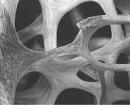
| Home | |
Investigators |
|
 |
|
|
|
||||||||||
OsteoporosisOsteoporosis literally means 'porous bone', a condition in which the bone becomes thinner and more fragile. Most bones are hollow inside and their strength comes from an outer solid cylinder lined by a more 'spongy ' type of bone that looks like a honeycomb. It is this (trabecular) bone that becomes much thinner in osteoporosis making it much more likely that the bone will break in a fall.
All bones are constantly remodelled (bone is continually broken down and replaced), but after the age of 35 more bone is lost than is replaced so the skeleton becomes very gradually thinner and weaker. The sex hormone oestrogen is an important factor in making bone and after the menopause the loss of calcium from the skeleton accelerates. A similar process may happen in men, because the sex hormone testosterone acts on the skeleton in a similar way to oestrogen, however because men have a larger, heavier skeleton the effect is less pronounced. Even so about a quarter of the fractures associated with osteoporosis occur in men. Osteoporosis also depends on genetic factors, diet, exercise and lifestyle. What are the symptoms? There are no specific symptoms - osteoporosis is usually first identified when a fracture occurs - often as a result of a relatively minor fall. Fractures of the wrist, hip and spine are the most common. How can osteoporosis be diagnosed? Diagnosis is by bone density measurements - a process similar to having an Xray. The measurement technique is called a DEXA scan (dual energy x-ray absorptiometry). The measurement is given as a T score. In women osteoporosis is defined as having a T score of less than -2.5. How is it treated? Treatment depends on the type of fracture and the medical history. Bisphosphonate drugs are commonly used but a range of other treatments are available. Advice on diet and lifestyle is also important. Questions patients ask I have a family history of osteoporosis. Can I do anything to prevent
it happening to me?
More information National Osteoporosis Society
|
||||||||||
| Text only | Accessibility | Search | Contact |